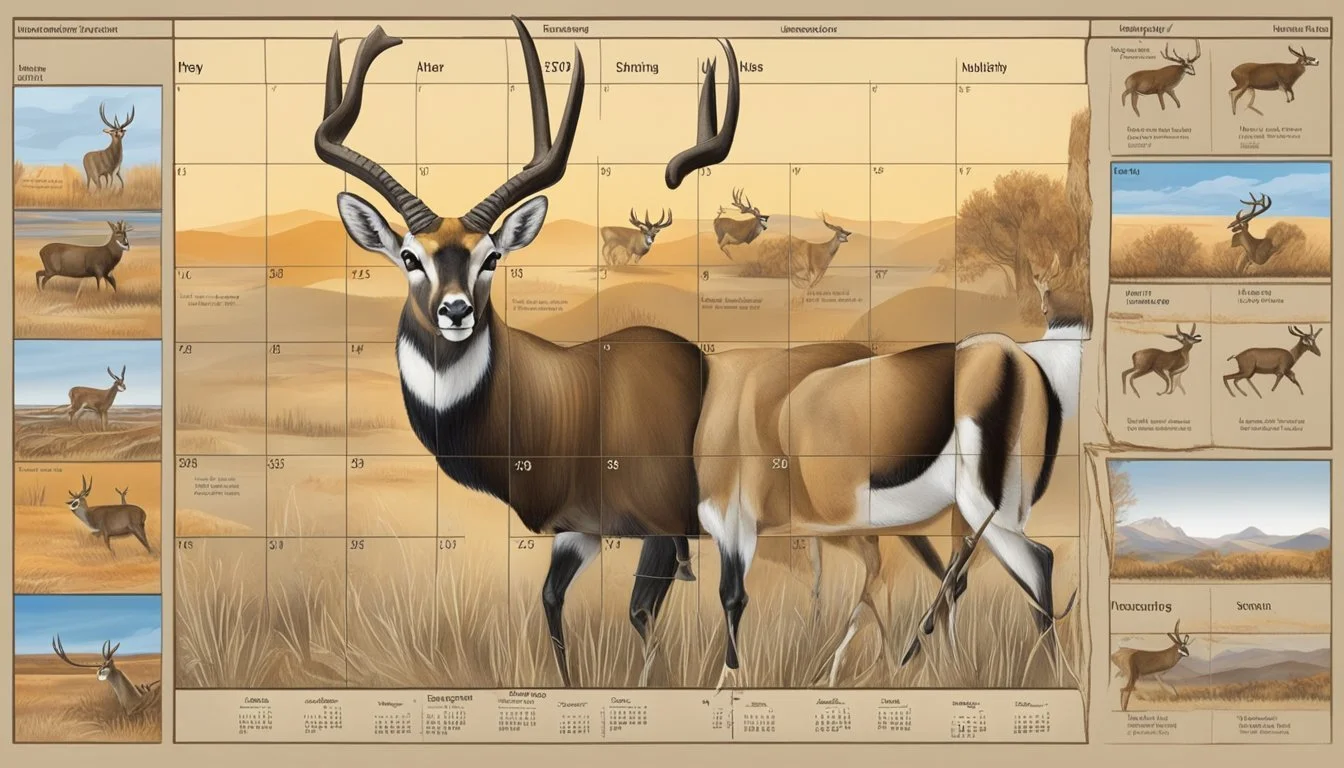Antelope Hunting Seasons
Regulations and Optimal Times
This Article is Part of Our Guide on Hunting Seasons for Over 70 Common Game Species
Antelope hunting, an activity deeply rooted in the tradition and management of wildlife in the Western United States, is an experience that offers hunters a unique interaction with one of North America’s most iconic grassland species, the pronghorn antelope. The pronghorn, often mistakenly referred to as an antelope, is celebrated for its remarkable speed and agility, which presents a stimulating challenge to hunters. Each year, hunting seasons for pronghorns are established, defining when and where hunters may pursue these swift ungulates, ensuring the species' sustainability and the balance of their habitats.
Across several states, including Wyoming and California, antelope hunting seasons are structured to maintain the health of pronghorn populations while providing hunters with ample opportunity. In Wyoming, for instance, all antelope hunt areas are managed under a limited quota system, which controls the number of licenses to maintain an ecological balance. Hunters interested in participating in these regulated seasons often turn to state wildlife agencies for information on season dates, hunt area descriptions, and the application processes for obtaining a permit.
Successful antelope hunting requires an understanding of the animal’s behaviors, preferred diets, and habitats. Pronghorns are selective feeders that graze on grasses, forbs, shrubs, and even cacti. Knowing the pronghorn's diet and range can lead hunters to prime locations during the hunting season. Since pronghorns are also known for their longevity, often reaching up to 10 years of age, hunters may encounter both youthful and mature animals, each offering a different level of challenge. The blend of respectful wildlife management and the exhilarating pursuit makes antelope hunting seasons a highlight for hunters each year.
Understanding Antelope and Their Habitat
In exploring the antelope's natural environment, one must consider the species' notable diversity and the unique behavioral adaptations they exhibit. These aspects combine to make each antelope well-suited to its surroundings.
Species Identification and Diversity
The term "antelope" encompasses a variety of species, with the pronghorn being one of the most iconic in North America. They are not true antelopes but are often grouped with them due to similar characteristics. The pronghorn (Antilocapra americana) is the sole surviving member of its family, Antilocapridae, and boasts an incredible evolutionary lineage dating back millions of years.
Species Distinction:
True antelopes: Belong to the family Bovidae and are native to Africa and Asia.
Pronghorn: Native to North America, often called "antelope" due to its resemblance.
Habitat Range: The pronghorn typically thrives in grasslands, deserts, and shrublands, emphasizing open terrains where visibility is high and predators are easier to spot.
Antelope Behavior and Adaptations
Antelopes are known for their agility and speed; pronghorns can reach speeds up to 60 miles per hour, making them the second-fastest land mammal. Their exceptional speed is a defensive adaptation to evade predators over the flatlands where they live. Antelopes possess keen eyesight, capable of spotting predators from a distance, and their large eyes are situated to provide a wide field of vision.
Anatomical Adaptations:
Speed: Supported by strong leg muscles, a specialized skeletal structure, and enlarged heart and lungs for enhanced oxygen exchange.
Eyesight: Large eyes positioned to give a nearly 360-degree field of vision.
Behavioral Traits:
Active mainly during the day (diurnal).
Family groups or herds for enhanced predator detection and protection.
Legal Framework for Antelope Hunting
The legal framework for antelope hunting governs the ethical and controlled harvest of these animals to ensure population sustainability and respect for wildlife laws. Hunters must navigate complex regulations, secure proper licensing, and adhere to designated season dates and zones.
Hunting Regulations Overview
Hunting regulations are established to manage wildlife populations effectively and to provide orderly and ethical hunting practices. In Oklahoma, for example, antelope hunting is closely regulated through the Oklahoma Department of Wildlife Conservation. Specific rules define what constitutes a legal buck, with a defining characteristic being a black cheek patch. Additionally, regulations may limit the number of antelope that can be harvested by one individual, often distinguishing between either-sex and buck-only tags.
License and Permit Requirements
To hunt antelope, licenses and permits are typically mandatory. Hunters usually need to apply for these documents before the season begins, with some states offering limited quota frameworks. For instance, in Wyoming, hunters apply for a set number of antelope licenses in particular hunt areas. In contrast, California includes antelope tags in its Big Game Hunting Digest, which also specifies tag quotas and drawings for other species.
Season Dates and Zones
The season for hunting antelope is delineated by specific season dates and divided into geographical zones:
Season Dates:
Jan 1-15: Counts toward the previous year's combined season limit.
Nov 25, 2023 - Jan 15, 2024: Specific Oklahoma gun hunting dates for antelope through controlled hunts or landowner permit drawing.
Zones:
Zone 1: May encompass regions with higher antelope populations and could have more generous tag allocations.
Zone 2: Often includes areas of moderate antelope density, with limited tag availability.
Zone 3: Can be designated for special management strategies or controlled hunts requiring additional permits.
Zone 4: Might be areas where hunting is either severely restricted or prohibited to allow for population recovery.
It should be noted that regulations, licenses, permits, and season dates may vary greatly between states and are subject to change. Hunters are responsible for staying informed about and compliant with the current laws and guidelines in the jurisdictions where they plan to hunt.
Preparation and Hunting Techniques
Preparing for an antelope hunt involves careful selection of equipment and thoughtful strategizing. Hunters must consider the unique challenges posed by the quarry and the environment in which they will be hunting.
Equipment and Gear Essentials
For a successful antelope hunt, one needs appropriate gear and equipment. Essential items include:
Firearm or Bow: Depending on the hunt type and season, either a high-caliber rifle for long shots or a compound bow for archery dates.
Optics: Quality binoculars and a spotting scope are critical for glassing and judging antelope from a distance.
Clothing: Layered, camouflaged attire suited to the season and terrain.
Footwear: Durable and comfortable boots designed for walking over uneven prairie terrain.
Effective Hunting Strategies
Effective strategies pivot on understanding antelope behavior and habitat:
Water Hole Ambush: Antelope often frequent water sources, so positioning near a water hole, with all factors like wind direction and concealment considered, can be effective.
Decoy Use: Utilizing a decoy during the rut can attract a territorial buck.
Spot-and-Stalk Methodology
The spot-and-stalk method requires patience and stamina:
First, Locate the antelope using high vantage points and optics.
Then, plan a Stalk taking into account the wind direction and cover.
Close the distance silently to within shooting range.
Archery-Specific Considerations
When hunting antelope with a bow, certain additional considerations apply:
Practice: Precision is crucial, so one must practice shooting at various distances.
Ground Blinds: These can be set up over waterholes, where archers can wait within range for antelope to approach.
State-Specific Hunting Information
Each state offers distinct opportunities and regulations for antelope hunting, with seasons varying in timing and requirements for residents and non-residents. Below is detailed state-specific information for the antelope hunting season.
Wyoming Antelope Hunting Season
In Wyoming, home to the largest antelope population in the country, hunters find a wealth of public land access, particularly in south-central and southwest regions. Residents and non-residents must apply for licenses through a draw system. The state provides ample hunting access on lands managed by the Bureau of Land Management (BLM).
Resident Access: Preference points system available for better draw odds
Season Dates: Variable; consult the Wyoming Game and Fish Department for current year specifics
Land Access: Extensive public lands, including BLM and state lands
Colorado Antelope Seasons
Colorado's antelope seasons are designed to manage populations sustainably while affording hunters ample opportunity. Both residents and non-residents can apply for licenses, with specific units designated for hunting on public and private lands.
Application: Both residents and non-residents apply through a lottery system
Habitat: Mixture of prairie and high-desert environments
Land Status: Mix of public (BLM, state lands) and private lands with access programs
Montana Pronghorn Opportunities
Montana offers expansive habitats for pronghorn antelope and conducts regular seasons for resident and non-resident hunters. The state is known for its fair chase hunting and sizeable pronghorn herds.
Licenses: Available through a combination of general tags and special permits
Public Land: Broad tracts of public land available, including Block Management Areas enhancing access to private land
Nebraska's Big Game Seasons
Nebraska provides pronghorn hunting opportunities mainly in the Panhandle region, promoting big game experiences for hunters. Both residents and non-residents can participate, with a limited number of permits ensuring a quality hunting experience.
Permit System: Draw system with preference points to assist repeat applicants
Environment: Predominantly private land with some public areas for hunting
Harvesting and Post-Hunt Procedures
Successful antelope hunting requires knowledgeable harvesting and conscientious post-hunt procedures. Hunters are responsible for ethical field dressing, adhering to tagging regulations, and participating in conservation efforts which are crucial for sustainable management of antelope populations.
Field Dressing and Transport
Once an antelope is harvested, the hunter must promptly and properly field dress the animal. This involves removing the internal organs to prevent meat spoilage, especially during warmer early seasons. It is vital to cool the carcass rapidly, utilizing game bags and ensuring it is shaded from direct sunlight during transport.
Reporting and Tagging
Every hunter is required to report their harvest according to state-specific regulations, often within a specified timeframe after the kill. For instance, the Nebraska Telecheck Program allows hunters to check in their game online or by phone, streamlining the process of tagging and reporting.
Telecheck Steps:
Call the telecheck number or visit the website.
Provide the required information (permit number, species, etc.).
Receive a confirmation number to validate the harvest.
The hunter then attaches the appropriate tag to the carcass, which usually includes details like date and area of the harvest.
Conservation and Management Practices
Conservation is key to maintaining a stable antelope population. Hunters contribute to management efforts by following established hunting seasons and adhering to bag limits. They may also partake in surveying and data collection initiatives that inform future wildlife management strategies.
Management Objectives:
Monitoring antelope migration patterns.
Adjusting seasons and limits based on population data.
Implementing strategies for habitat improvement and predator management.
Compliance with these post-hunt procedures ensures ethical hunting, aids in wildlife management, and supports conservation initiatives for the pronghorn antelope.
Ethical Hunting Considerations
When hunting antelope, the sportsman must navigate a landscape of ethical practices. These practices ensure the activity is conducted with respect for the animal, landowners, and the environment.
Fair Chase Ethics
Fair chase refers to a set of hunting ethics that promote a respect for the animal and the heritage of hunting. These principles dictate that:
The hunter should pursue antelope in a manner that does not give the hunter an unfair advantage.
Technological aids should be limited to ensure the hunt remains a test of the hunter's skill and knowledge.
Landowner Relations and Permissions
In the context of antelope hunting, landowner relations are crucial. Hunters should:
Always obtain written permission from landowners before hunting on their land.
Use available maps to confirm property boundaries and avoid trespassing.
Respect the landowner's property by leaving gates as they find them and refraining from causing any form of damage.
Contribution to Biodiversity and Habitat
Hunting can play a role in maintaining the diversity of species and habitats. Ethical hunters should understand and participate in:
Conservation efforts by following game regulations that support antelope population control and habitat management.
Programs that contribute financially to the conservation of antelope habitats and encourage a sustainable balance in the ecosystem.





